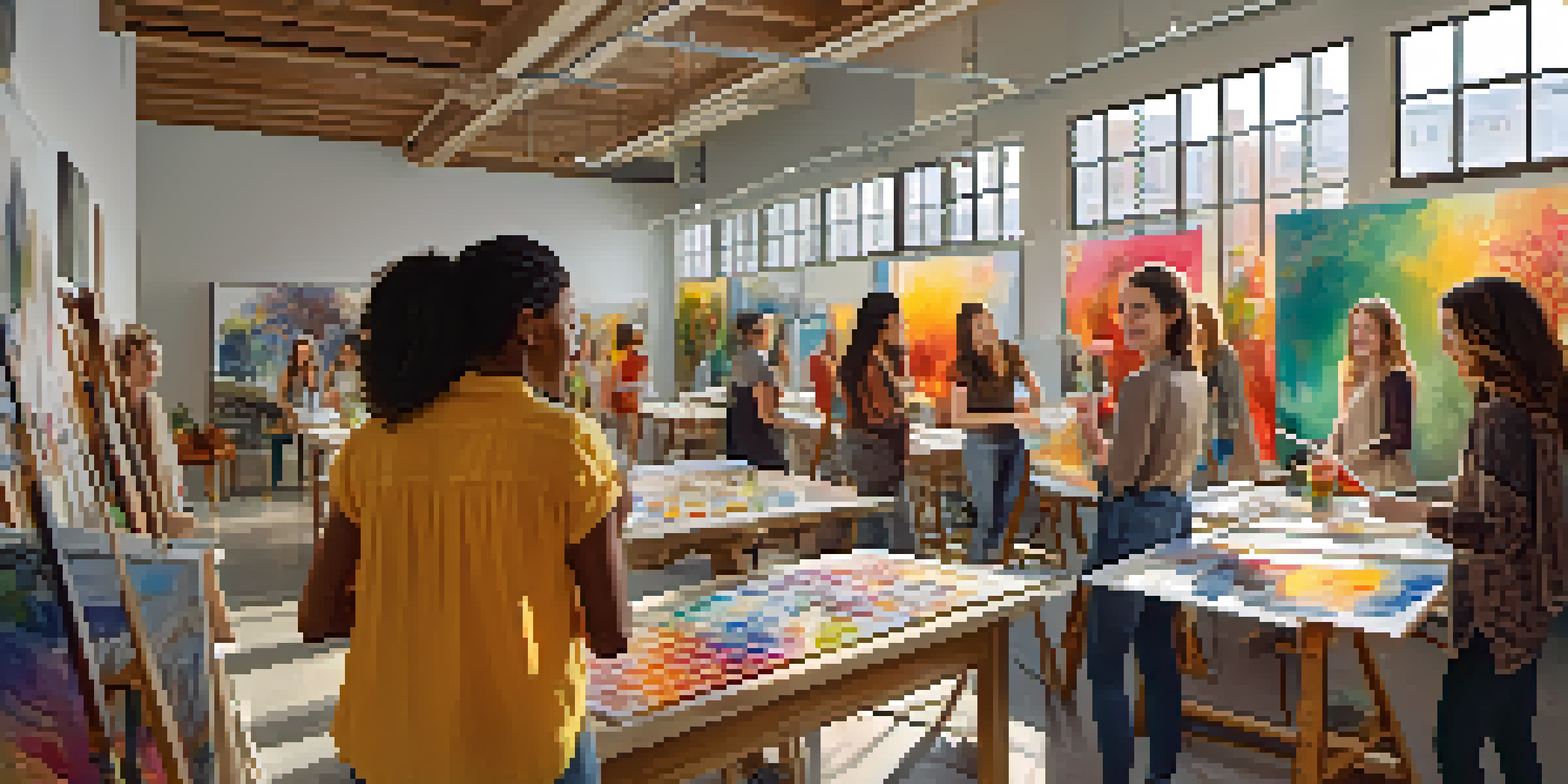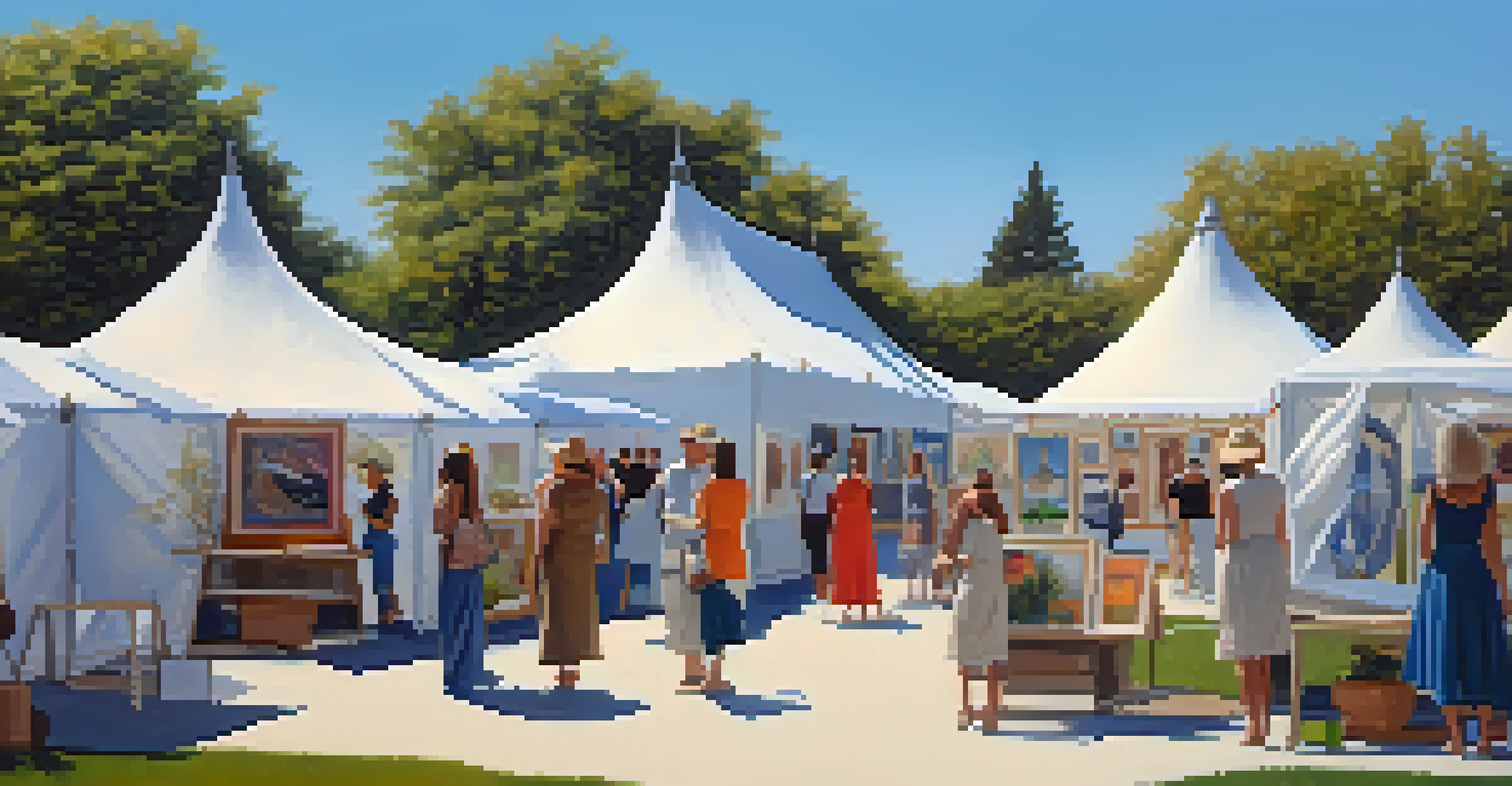The Role of Social Media in Promoting Women Artists' Work

Social Media: A Game Changer for Women Artists
In recent years, social media has transformed how artists showcase their talents. For women artists, platforms like Instagram and Twitter offer unprecedented access to a global audience. This shift allows them to bypass traditional gatekeepers in the art world, such as galleries and curators, providing a direct line to potential fans and collectors.
Social media is about the people. Not about your business. Provide for the people and the people will provide you.
Not only can women artists share their work, but they can also tell their stories, creating a deeper connection with audiences. For instance, a painter might share behind-the-scenes glimpses of their process or discuss the inspiration behind a piece. This personal engagement can foster a loyal following, which is vital in the competitive art market.
Moreover, social media enables artists to collaborate and network with peers across the world. By participating in online communities, women artists can support one another, share resources, and amplify each other's voices, creating a thriving ecosystem that celebrates diverse artistic expressions.
Building a Personal Brand Through Social Media
One of the most powerful aspects of social media is its ability to help artists build a personal brand. For women artists, curating their online presence can significantly enhance their visibility. By sharing their work consistently and engaging with followers, they can establish a recognizable aesthetic and voice that resonates with their audience.

Consider an artist who regularly posts her artwork alongside personal anecdotes about her journey. This approach not only showcases her talent but also humanizes her brand, making it more relatable. As followers connect with her story, they are more likely to support her work, whether through purchases or by spreading the word.
Social Media Empowers Women Artists
Platforms like Instagram and Twitter provide women artists with direct access to audiences, allowing them to share their work and stories without traditional gatekeepers.
Additionally, a strong online presence can lead to exciting opportunities, such as collaborations with brands or features in online publications. These moments can elevate an artist's profile and open doors that may have previously seemed out of reach, further solidifying their place in the art world.
Community Engagement and Support Networks
Social media is also a powerful tool for fostering community among women artists. Through hashtags like #WomenArtists and #ArtForChange, they can connect with like-minded individuals and cultivate a sense of belonging. This supportive environment encourages collaboration, mentorship, and sharing of resources, which can be invaluable for emerging artists.
Art is not freedom from discipline, but disciplined freedom.
For instance, many women artists use social media to organize group exhibitions or virtual art shows, allowing them to showcase their work collectively. This type of collaboration not only amplifies individual voices but also highlights the shared experiences of women in the art community, creating a collective impact.
Moreover, these online networks provide a platform for discussions around challenges faced by women in the arts, such as representation and equity. By bringing these issues to light, artists can advocate for change while also rallying support from their followers, creating a community that is both empowering and proactive.
Navigating Challenges and Online Criticism
While social media offers numerous benefits, it also presents challenges, particularly regarding online criticism. Women artists may face negative comments or harassment that can undermine their confidence and creativity. However, learning to navigate this landscape is essential for maintaining a healthy online presence.
Developing a thick skin is beneficial, but so is fostering a supportive community that can help combat negativity. Many artists share their experiences with criticism on social media, creating space for open conversations about mental health and resilience. This transparency can encourage others to speak up and seek support when faced with similar challenges.
Building Brands and Opportunities
By curating their online presence, women artists can establish a recognizable brand, leading to increased visibility and exciting collaboration opportunities.
Additionally, artists can use criticism as a learning opportunity, reflecting on feedback to grow and evolve their work. By reframing negative experiences, women artists can empower themselves and turn potential setbacks into stepping stones for success.
The Rise of Online Art Sales and Marketplaces
The digital landscape has also paved the way for new avenues of income, such as online art sales and marketplaces. Platforms like Etsy and Saatchi Art allow women artists to sell their work directly to consumers, eliminating the need for intermediaries. This democratization of the art market can lead to increased financial independence for female artists.
By leveraging social media to promote their online shops, artists can reach potential buyers without the constraints of traditional galleries. A well-crafted Instagram post showcasing a new piece can drive traffic to their online store, making it easier to convert followers into customers.
Moreover, this shift to online sales encourages artists to take control of their pricing and branding. Women artists can experiment with different styles and price points, allowing them to find what resonates with their audience while ensuring they are compensated fairly for their work.
Highlighting Underrepresented Voices in the Art World
Social media serves as a platform for amplifying underrepresented voices, particularly those of women artists. Initiatives like #5WomenArtists encourage conversations about the lack of visibility for female creators in the art world. By participating in these movements, artists can raise awareness and advocate for change within the industry.
When artists share their stories and experiences, they can inspire others to join the conversation. For example, showcasing the work of lesser-known women artists alongside established figures helps to level the playing field. This visibility not only benefits individual artists but also enriches the art community as a whole.
Community and Support Networks Grow
Social media fosters a supportive community for women artists, enabling collaboration, mentorship, and discussions around challenges faced in the art industry.
Ultimately, social media allows for a more diverse representation of art, challenging traditional norms and highlighting the importance of inclusivity. As more women artists gain recognition, they can redefine the art landscape, contributing to a more equitable future.
The Future of Women Artists in the Digital Age
As we look ahead, it's clear that social media will continue to play a crucial role in shaping the careers of women artists. The ability to share work, connect with audiences, and build supportive networks is invaluable in today’s digital landscape. As technology evolves, so too will the opportunities for creativity and collaboration.
Emerging trends, such as virtual reality and augmented reality art experiences, may further expand the horizons for women artists. These innovations can create new ways for artists to engage with their audiences and showcase their work, making art more accessible than ever before.

Ultimately, the future is bright for women artists in the digital age. With the power of social media at their fingertips, they have the tools to reclaim their narratives, celebrate their creativity, and push the boundaries of what is possible in the art world.